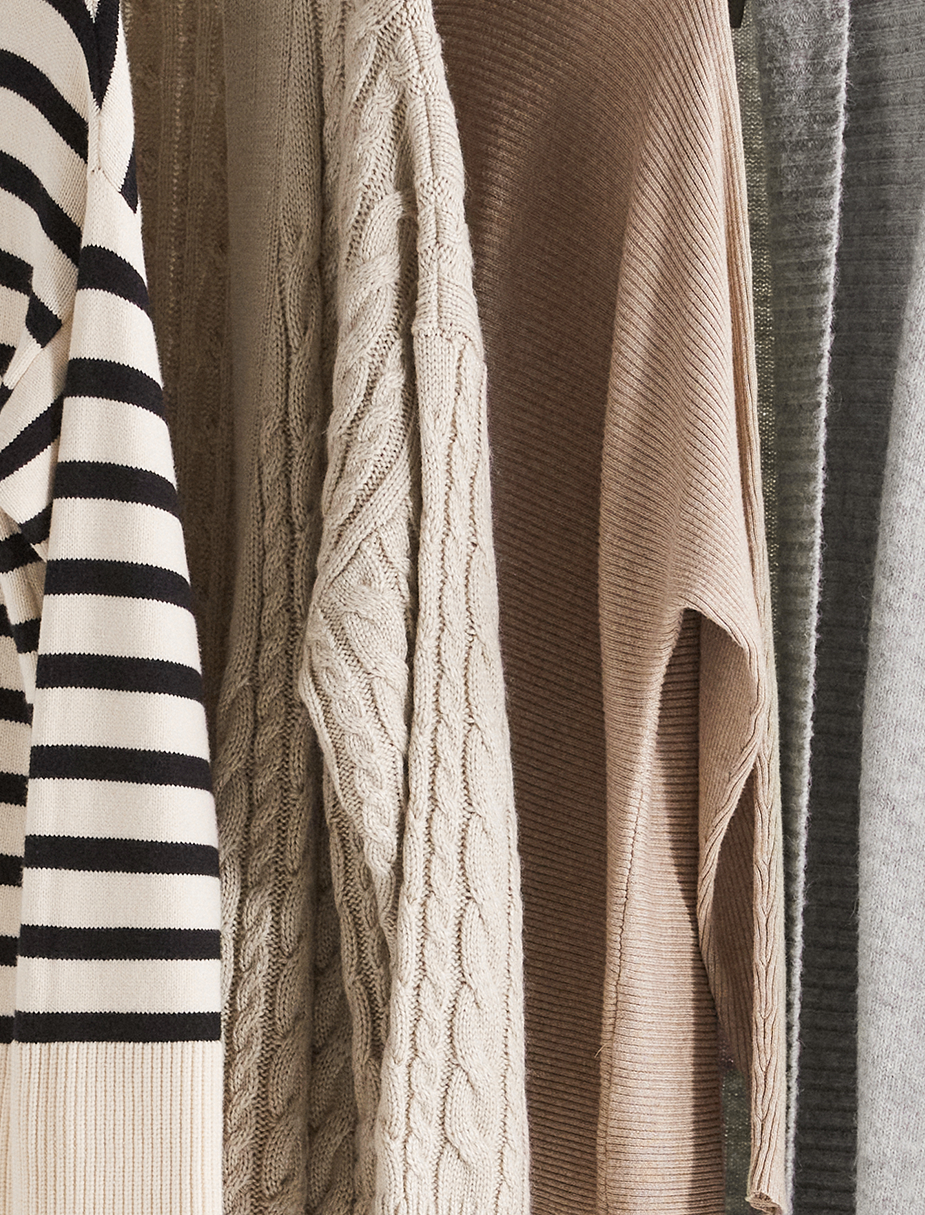WEAR & CARE
How you wear, wash, and care for your clothes impacts comfort, longevity and sustainability. Small choices can make a big difference!
WEAR AND CARE GUIDE
READ THE CARE LABEL
Care instructions are on the inside of the garment, usually on the wearer's left.
All our garments have been thoroughly tested, including wash testing to extend the life of the garment and achieve the best appearance after wash.
The Sussan Group will always specify cold wash unless warm wash is required for hygiene purposes.
Following care instructions prolongs the life of your garments.
WASH LESS
Washing your clothes less increases the life span of your garments. Air out between wears.
Direct sunlight sterilises – turn your garment inside out (particularly denim and pants) and put on the washing line in direct sunlight for 3-4 hours +
Spot clean marks and stains if necessary. Diluted clothes washing detergent and a damp cloth can effectively remove stains if they are treated immediately.
FILL YOUR MACHINE
Wash colours together – whites / colours / darks. This maintains the colours of your garments for longer.
Wash / clean sets together to ensure they match.
Wash like garments together, separating delicates from heavy-duty garments like towels and jeans.
Wash delicates in garment bags.
Turn your garments inside out to prevent colour fading, particularly prints and garments with contrast trims.
Don’t overfill the machine as it causes more abrasion between garments.
USE BIODEGRADABLE / GREEN DETERGENTS
Choose biodegradable, environmentally friendly detergents.
Avoid harsh bleaches, fabric softeners or detergents with optical brighteners as they degrade the fabrics and colours.
Add vinegar to wash cycle to remove odour, mildew, and bacteria. Vinegar shouldn't be used with elasticated fabrications, and should only be used on an as need basis. Dilute half a cup of vinegar in water, and add before the final rinse cycle for the best outcome.
SYNTHETICS
Microplastics are fragments of plastic less than 5mm in length. Synthetic clothing made from fabrications including polyester and nylon can shed microplastic fibres in the wash that make it into our waterways and oceans.
Use a microplastic filter or guppy friendly wash bag to wash synthetics (polyester and nylon). This prevents the microplastics from entering our water supply.
AIR DRY RATHER THAN TUMBLE DRY
Air drying is far better for your clothing than tumble drying.
We recommend drying your clothes outside whenever possible as direct sunlight kills bacteria.
To preserve garment colours for longer you can also turn them inside out on the clothes line.
Using coat hangers for items like washable jackets, shirts and blouses will help them dry in shape.
DON'T IRON UNLESS NECESSARY
Steaming works well if you need to reduce creasing between wears.
CHOOSE ECO FRIENDLY DRY CLEANING
Dry cleaning is recommended for structured and tailored jackets and coats, and certain fabrications.
Try to air out between wears and spot clean when necessary to extend time between dry cleans.
Dry clean sets together to keep them matching.
Choose eco friendly dry cleaning whenever possible.
END OF LIFE
Before discarding an item, check if it can be repaired. Small fixes, such as stitching a tear, replacing buttons, or patching holes, can extend a garment's lifespan by years. Learning basic sewing skills or visiting a tailor can also help keep clothes wearable for longer.
Repurpose. Resell or Donate. Recycle Responsibly.
Denim Care Made Simple
WASH SPARINGLY
Denim fades over time, creating a unique, worn-in look. Wash only when necessary, turn inside out and air out in sunlight, and spot clean minor stains instead of washing the entire garment.
GENTLE WASHING
When washing is needed, turn denim inside out, use a mild detergent, and wash in cold water with similar colours to prevent fading and dye transfer. Dark denim may bleed, so wash before wearing and avoid contact with light fabrics.
AIR DRY FOR LONGEVITY
Skip the dryer—heat can shrink and weaken fibres. Lay flat or hang to dry in the shade to maintain shape and prevent sun bleaching.
SMART STORAGE
Store in a cool, dry place, folded or hung, to keep denim looking its best for years.

Linen Care Made Simple
WASH WITH CARE
With regular wear and washing, linen will soften over time, giving it a relaxed, worn-in feel.
AIR DRY FOR BEST RESULTS
Skip the wringing—just reshape while damp and lay flat or hang to dry. Whites love the sun (it keeps them bright!), but coloured linens should dry in the shade or inside out to avoid fading. Tumble drying can make linen brittle, so air drying is best for both the fabric and the planet.
IRONING (ONLY IF YOU MUST)
If wrinkles bother you, iron linen while it’s still slightly damp, using a warm iron on the reverse side. Place a damp tea towel over the spot before ironing for tough creases. A handheld steamer is a great way to refresh linen between washes.
SMART STORAGE
Store in a cool, dry place with good airflow. Hanging works well, but if you’re folding, use breathable linen or cotton garment bags to keep pieces fresh.

Cotton Care Made Simple
WASH WITH CARE
Cool washes help preserve cotton’s quality, brightness, and colour while being kinder to the environment. Use a garment bag for delicate items, unbutton shirts, and fasten zips to prevent snagging. Turn prints and colours inside out. Pre-treat stains on necklines and underarms, patch-testing on dark fabrics before applying stain remover.
DRY NATURALLY
Air drying maintains shape, prevents static, and reduces wrinkles. Reshape damp garments and lay flat or hang to dry. Whites stay bright in the sun, while coloured cotton should dry in the shade or inside out to prevent fading. Avoid tumble drying to prevent shrinkage.
IRON IF NEEDED
For best results, iron while slightly damp on a warm setting. Turn coloured cotton inside out and use a cool temperature to protect vibrancy. A handheld steamer is a great alternative to refresh garments and extend time between washes.
SMART STORAGE
Store in a cool, dry space away from sunlight to prevent fading. Use dressers, drawers, or shelves with airflow and avoid airtight plastic or cardboard boxes to prevent moisture buildup.

Knitwear Care Made Simple
WASHING
Handwashing is ideal, but a cold wool wash cycle with like colours is fine if time is tight. Use an eco-friendly wool detergent and a gentle spin to remove excess water. Don’t overcrowd the machine to ensure a gentle wash.
For stains, gently blot with a clean, damp cloth and diluted wool detergent—avoid scrubbing. Refrain from using harsh stain removers or bleach-based detergents as they may damage the fabric and colour of your knits.
DRYING
Never wring or hang-dry knitwear. Instead, roll in a towel to absorb excess water, then lay flat to dry on a clean towel or drying rack. Avoid direct heat sources like heaters, as they can shrink the fabric. If your knit is ironable, use a light press to restore its shape.
STORAGE
Fold your knits and store them in a cool, dry space to avoid distortion from hanging. Always store clean and leave space between folded garments to prevent moths and damage.
PILLING
To remove pills (lint balls), use a fabric comb or sweater comb, testing on an inconspicuous area first. A fabric shaver is also effective and portable for larger areas. Avoid pulling pills off by hand to prevent fabric damage.


